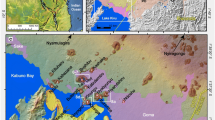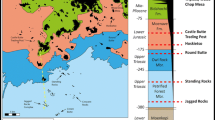Abstract
Orakei maar and tuff ring in the Auckland Volcanic Field is an example of a basaltic volcano in which the style and impacts of the eruption of a small volume of magma were modulated by a fine balance between magma flux and groundwater availability. These conditions were optimised by the pre-85 ka eruption being hosted in a zone of fractured and variably permeable Plio-Pleistocene mudstones and sandstones. Orakei maar represents an end-member in the spectrum of short-lived basaltic volcanoes, where substrate conditions rather than the magmatic volatile content was the dominant factor controlling explosivity and eruption styles. The eruption excavated a crater ≫80 m deep that was subsequently filled by slumped crater wall material, followed by lacustrine and marine sediments. The explosion crater may have been less than 800 m in diameter, but wall collapse and wave erosion has left a 1,000-m-diameter roughly circular basin. A tuff ring around part of the maar comprises dominantly base surge deposits, along with subordinate fall units. Grain size, texture and shape characteristics indicate a strong influence of magma–water and magma–mud interactions that controlled explosivity throughout the eruption, but also an ongoing secondary role of magmatic gas-driven expansion and fragmentation. The tuff contains >70 % of material recycled from the underlying Plio-Pliestocene sediments, which is strongly predominant in the >2 ϕ fraction. The magmatic clasts are evolved alkali basalt, consistent with the eruption of a very small batch of magma. The environmental impact of this eruption was disproportionally large, when considering the low volume of magma involved (DRE < 0.003 km3). Hence, this eruption exemplifies one of the worst-case scenarios for an eruption within the densely populated Auckland City, destroying an area of ~3 km2 by crater formation and base surge impact. An equivalent scenario for the same magma conditions without groundwater interaction would yield a scoria/spatter cone with a diameter of 400–550 m, destroying less than a tenth of the area affected by the Orakei event.











Similar content being viewed by others
References
Allen SR, Smith IEM (1994) Eruption styles and volcanic hazard in Auckland Volcanic Field, New Zealand. Geosci Rep Shizuoka Uni 20:5–14
Allen SR, Bryner VF, Smith IEM, Ballance PF (1996) Facies analysis of pyroclastic deposits within basaltic tuff-rings of the Auckland volcanic field, New Zealand. New Zealand J Geol Geophys 39:309–327
Auer A, Martin U, Németh K (2007) The Fekete-hegy (Balaton Highland Hungary) “soft-substrate” and “hard-substrate” maar volcanoes in an aligned volcanic complex—implications for vent geometry, subsurface stratigraphy and the palaeoenvironmental setting. J Volcanol Geotherm Res 159:225–245
Bebbington MS, Cronin SJ (2011) Spatio-temporal hazard estimation in the Auckland Volcanic Field, New Zealand, with a new event-order model. Bull Volcanol 73:55–72
Brand BD, Clarke AB (2009) The architecture, eruptive history, and evolution of the Table Rock Complex, Oregon: from a Surtseyan to an energetic maar eruption. J Volcanol Geotherm Res 180:203–224
Brenna M, Cronin SJ, Smith IEM, Sohn YK, Németh K (2010) Mechanisms driving polymagmatic activity at a monogenetic volcano, Udo, Jeju Island, South Korea. Contr Min Petrol 160:931–950
Brown RJ, Branney MJ, Maher C, Dávila-Harris P (2010) Origin of accretionary lapilli within ground-hugging density currents: Evidence from pyroclastic couplets on Tenerife. Geol Soc Am Bull 122(1/2):305–320
Bultitude RJ, Green DH (1971) Experimental study of crystal–liquid relationships at high pressures in olivine nephelinite and basanite compositions. J Petrol 12:121–147
Büttner R, Dellino P, La Volpe L, Lorenz V, Zimanowski B (2002) Thermohydraulic explosions in phreatomagmatic eruptions as evidenced by the comparison between pyroclasts and products from Molten Fuel Coolant Interaction experiments. J Geophys Res-Solid Earth 107(B11): art. no.-2277
Carey S, Maria A, Sigurdsson H (2000) Use of fractal analysis for discrimination of particles from primary and reworked jokulhlaup deposits in SE Iceland. J Volcanol Geotherm Res 104:65–80
Carn SA (2000) The Lamongan volcanic field, East Java, Indonesia: physical volcanology, historic activity and hazards. J Volcanol Geotherm Res 95:81–108
Cassidy J, France SJ, Locke CA (2007) Gravity and magnetic investigation of maar volcanoes, Auckland volcanic field, New Zealand. J Volcanol Geotherm Res 159:153–163
Dellino P, La Volpe L (1996) Image processing analysis in reconstructing fragmentation and transportation mechanisms of pyroclastic deposits. The case of Monte Pilato–Rocche Rosse eruptions, Lipari (Aeolian Islands, Italy). J Volcanol Geotherm Res 71:13–29
Dellino P, Liotino G (2002) The fractal and multifractal dimension of volcanic ash particles contour: a test study on the utility and volcanological relevance. J Volcanol Geotherm Res 113:1–18
Dellino P, Frazzetta G, La Volpe L (1990) Wet surge deposits at La Fossa di Vulcano: depositional and eruptive mechanisms. J Volcanol Geotherm Res 43:215–233
Dellino P, Isaia R, La Volpe L, Orsi G (2004a) Interaction between particles transported by fallout and surge in the deposits of the Agnano-Monte Spina eruption (Campi Flegrei, Southern Italy). J Volcanol Geotherm Res 133:193–210
Dellino P, Isaia R, Veneruso M (2004b) Turbulent boundary layer shear flows as an approximation of base surges at Campi Flegrei (Southern Italy). J Volcanol Geotherm Res 133:211–228
Edbrooke SW, Masengarb C, Stephenson W (2003) Geology and geological hazards of the Auckland urban area, New Zealand. Quatern Inter 103:3–21
Gebhardt AC, De Batist M, Niessen F, Anselmetti FS, Ariztegui D, Haberzettl T, Kopsch C, Ohlendorf C, Zolitschka B (2011) Deciphering lake and maar geometries from seismic refraction and reflection surveys in Laguna Potrok Aike (southern Patagonia, Argentina). J Volcanol Geotherm Res 201(1–4):357–363
Houghton BF, Schmincke HU (1986) Mixed deposits of simultaneous strombolian and phreatomagmatic volcanism; Rothenberg Volcano, East Eifel volcanic field. J Volcanol Geotherm Res 30:117–130
Houghton BF, Wilson CJN, Smith IEM (1999) Shallow-seated controls on styles of explosive basaltic volcanism: a case study from New Zealand. J Volcanol Geotherm Res 91:97–120
Kienle J, Kyle PR, Self S, Motyka RJ, Lorenz V (1980) Ukinrek Maars, Alaska.1. April 1977 eruption sequence, petrology and tectonic setting. J Volcanol Geotherm Res 7:11–37
Lesti C, Giordano G, Salvini F, Cas RAF (2008) Volcano tectonic setting of the intraplate, pliocene–holocene, newer volcanic province (southeast Australia): Role of crustal fracture zones. J Geophys Res—Solid Earth 113(B7): Article #: B07407
Lorenz V (1974) Vesiculated tuffs and associated features. Sedimentology 21:273–291
Lorenz V (2003) Maar-diatreme volcanoes, their formation, and their setting in hard-rock or soft-rock environments. Geolines 15:72–83
Mandelbrot BB (1967) How long is the coast of Britain? Statistical self-similarity and fractal dimension. Science 156:636–638
McGee LE, Beier C, Smith IEM, Turner SP (2011) Dynamics of melting beneath a small-scale basaltic system: a U–Th–Ra study from Rangitoto volcano, Auckland volcanic field, New Zealand. Contrib Min Petr 162(3):547–563
Molloy C, Shane P, Augustinus P (2009) Eruption recurrence rates in a basaltic volcanic field based on tephra layers in maar sediments: implications for hazards in the Auckland volcanic field. Geol Soc Am Bull 121:1666–1677
Needham AJ, Lindsay JM, Smith IEM, Augustinus P, Shane PA (2011) Sequential eruption of alkaline and sub-alkaline magmas from a small monogenetic volcano in the Auckland Volcanic Field, New Zealand. J Volcanol Geotherm Res 201:126–142
Németh K (2010) Monogenetic volcanic fields: Origin, sedimentary record, and relationship with polygenetic volcanism. In: E. Cañón-Tapia and A. Szakács (Editors), What Is a Volcano? GSA Special Papers [Geological Society of America, Boulder, Colorado] 470: 43–67
Németh K, Cronin SJ (2007) Syn- and post-eruptive erosion, gully formation, and morphological evolution of a tephra ring in tropical climate erupted in 1913 in West Ambrym, Vanuatu. Geomorphology 86:115–130
Ort MH, Wohletz K, Hooten JA, Neal CA, McConnel VS (2000) The Ukinrek maars eruption, Alaska, 1977: a natural laboratory for the study of phreatomagmatic processes at maars. Terra Nostra 2000(6):396–400
Pardo N, Macias JL, Guido G, Cianfarra P, Avellan DR, Bellatreccia F (2009) The similar to 1245 yr BP Asososca maar eruption: the youngest event along the Nejapa-Miraflores volcanic fault, Western Managua, Nicaragua. J Volcanol Geotherm Res 184:292–312
Pirrung M, Buechel G, Volker L, Treutler HC (2008) Post-eruptive development of the Ukinrek East Maar since its eruption in 1977 AD in the periglacial area of south-west Alaska. Sedimentology 55(2):305–334
Ross P-S, White JDL (2006) Debris jets in continental phreatomagmatic volcanoes: A field study of their subterranean deposits in the Coombs Hills vent complex, Antarctica. J Volcanol Geotherm Res 149:62–84
Ross P-S, Delpit S, Haller MJ, Németh K, Corbella H (2011) Influence of the substrate on maar–diatreme volcanoes—an example of a mixed setting from the Pali Aike volcanic field, Argentina. J Volcanol Geotherm Res 201:253–271
Russell WJ, Rodgers KA (1977) Waters of the Western Spring catchment, Auckland. New Zealand J Marine Freshwater Res 11:713–728
Smith IEM, Blake S, Wilson CJN, Houghton BF (2008) Compositional zoning in a small volume monogenetic basaltic volcano in the Auckland volcanic Auckland volcanic field, New Zealand. Contr Min Petrol 155:511–527
Sohn YK, Park KH (2005) Composite tuff ring/cone complexes in Jeju Island, Korea: possible consequences of substrate collapse and vent migration. J Volcanol Geotherm Res 141:157–175
Sohn YK, Cronin SJ, Brenna M, Smith IEM, Németh K, White JDL, Murtagh RM, Jeon YM, Kwon CW (2012) Ilchulbong tuff cone, Jeju Island, Korea, revisited: a compound monogenetic volcano involving multiple magma pulses, shifting vents, and discrete eruptive phases. Geol Soc Am Bull 124(3–4):259–274
Suhr P, Goth K, Lorenz V (2006) Long lasting subsidence and deformation in and above maar-diatreme volcanoes—a never ending story. Z deutsch Ges Geowissen 157:491–511
Valentine GA (1987) Stratified flow in pyroclastic surges. Bull Volcanol 49:616–630
Valentine GA, Gregg TKP (2008) Continental basaltic volcanoes—processes and problems. J Volcanol Geotherm Res 177:857–873
White JDL (1991) The depositional record of small, monogenetic volcanoes within terrestrial basins. In: Fisher RV, Smith GA (eds) Sedimentation in volcanic settings. Society for Sedimentary Geology, Tulsa (Oklahoma), pp 155–171
White JDL, Ross P-S (2011) Maar–diatreme volcanoes: a review. J Volcanol Geotherm Res 201:1–29
Wood CA (1980) Morphometric evolution of cinder cones. J Volcanol Geotherm Res 7:387–413
Acknowledgements
The authors acknowledge support from the Foundation for Research, Science and Technology International Investment Opportunities Fund, Project MAUX0808 “Facing the challenge of Auckland volcanism” and KN was assisted by the Massey University Research Fund (RM13444). Prof. Claus Siebe and an Anonymous Reviewer provided helpful reviews and we also thank Editors Jeremy Phillips and James White for their contributions toward improving the manuscript.
Author information
Authors and Affiliations
Corresponding author
Additional information
Editorial responsibility: J. C. Phillips
Rights and permissions
About this article
Cite this article
Németh, K., Cronin, S.J., Smith, I.E.M. et al. Amplified hazard of small-volume monogenetic eruptions due to environmental controls, Orakei Basin, Auckland Volcanic Field, New Zealand. Bull Volcanol 74, 2121–2137 (2012). https://doi.org/10.1007/s00445-012-0653-6
Received:
Accepted:
Published:
Issue Date:
DOI: https://doi.org/10.1007/s00445-012-0653-6




